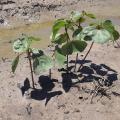Sand Blasting Injury
Sand blasting is generally not a wide spread problem for us. However, some problems do occur to some degree each year. Blowing sand can open wounds in the plant tissue which allows pathogens access. Wind driven soil particles may even carry herbicide residue directly into the plant tissue. The additive effects of these injuries can be detrimental to cotton seedlings.
 In problem evaluations, the first rule is to not make the final judgment on the extent of damage to the crop too quickly. Cotton has a tremendous capacity to recover from adversities. Consequently, it is usually best to delay the final stand evaluation until after the crop is exposed to 2 or 3 days of good growing conditions. Symptoms of sand blasting can range from minor burns to complete desiccation and plant death. In minor problems, the small stems will be very red on one side, the cuticle of the stem and leaves will be abraded away and the leaves will have a scorched appearance. Cotton will generally recover quite well from these symptoms.
In problem evaluations, the first rule is to not make the final judgment on the extent of damage to the crop too quickly. Cotton has a tremendous capacity to recover from adversities. Consequently, it is usually best to delay the final stand evaluation until after the crop is exposed to 2 or 3 days of good growing conditions. Symptoms of sand blasting can range from minor burns to complete desiccation and plant death. In minor problems, the small stems will be very red on one side, the cuticle of the stem and leaves will be abraded away and the leaves will have a scorched appearance. Cotton will generally recover quite well from these symptoms.
As the symptoms get worse, stems will show signs of splitting, cracking, necrosis of tissue and develop a dark brown to black color. Leaves will especially develop a black appearance. This discoloration will generally develop within a day of the wind storm event. Sometimes the symptoms start out very mild and progressively get worse. This is especially true if windy conditions persist for several days.
As fields are evaluated for damage there are several things to look for and consider. First take note of your growing area and the calendar date. Next take note of the soil productivity and whether the field is irrigated or not. Calendar date and soil productivity must be considered and will aid in deciding whether or not to keep the stand, replant to cotton or to replant to an alternative crop. Also growers should have an in-depth knowledge of his insurance coverage and provisions.
 As you evaluate the fields generally you will notice that damage will be worse on the higher ridges of the field. Damage will be less in the lower areas and areas sheltered by wind breaks. After the areas effected have been identified, plants should be examined to determine the extent of the damage. Examine plants from several places within the damaged areas. Look closely at the stems - evaluate cracks, breaks, and abraded areas. Scrape through the epidermis with a knife blade to the determine wound depth. Especially note whether or not the wound extends deeper than the cuticle into, or through, the stele.
As you evaluate the fields generally you will notice that damage will be worse on the higher ridges of the field. Damage will be less in the lower areas and areas sheltered by wind breaks. After the areas effected have been identified, plants should be examined to determine the extent of the damage. Examine plants from several places within the damaged areas. Look closely at the stems - evaluate cracks, breaks, and abraded areas. Scrape through the epidermis with a knife blade to the determine wound depth. Especially note whether or not the wound extends deeper than the cuticle into, or through, the stele.
If the wound has penetrated the cuticle and not damaged the stele, the stem will most likely form callus tissue and scar over the wound. If the wound extends into the stele, it is likely that the stem will break before the plant can recover. In making stand counts, only count plants that have superficial and recoverable damage to the stem.
Damage to the leaves may range from slight abrasion of the cuticle to complete desiccation. Loss of the waxy cuticle from the cotyledon and true leaves will hasten water loss contributing to desiccation. If leaf burn and desiccation is a problem, examine the last expanding true leaf and the tissue in the terminal. If the last expanding true leaf only has mild damage and the tissue in the terminal is still green, the plant will most likely recover. That is of course if the stem is still viable.
 For help in making replant decisions refer to the Replant Page. Generally as you get to May 20, 2 plants per foot of row in a 38 to 40 inch row is adequate to make a normal yield. As you approach the end of May you may choose to tolerate populations in the 1.7 plants per row foot range. Number of skips and size of skips must be taken into account. Deciding to replant cotton in late May to early June requires a knowledge of soil productivity, geographic area, irrigation capability and the economics of soybeans planted at that date.
For help in making replant decisions refer to the Replant Page. Generally as you get to May 20, 2 plants per foot of row in a 38 to 40 inch row is adequate to make a normal yield. As you approach the end of May you may choose to tolerate populations in the 1.7 plants per row foot range. Number of skips and size of skips must be taken into account. Deciding to replant cotton in late May to early June requires a knowledge of soil productivity, geographic area, irrigation capability and the economics of soybeans planted at that date.
In fields where blowing sand is a perennial problem, corrective (preventative) measures can be taken. The picture representing planting cotton notill into a cover crop is one of the best fixes going. There are several ways to accomplish this. In the fall, row the field up and fly (broadcast) wheat into the field (keep seeding rates low, in the 40 to 60 pound range as you are not planting for grain nor for grazing). Then, the field may be either rehipped or you may wish to drag the rows somewhat flat. If the field is rehipped in the fall, it may need dragging down a little in the spring which may reduce some of the effectiveness of the what as a wind break, but it will still be much better than nothing. In the spring, let the wheat grow tall and head out before it is burned down. Burn the wheat down about two weeks ahead of planting. At planting you may need additional burn down but make that decision on the spot. As the field is planted the use of a systemic insecticide for thrip control is recommended and cutworm control is also recommended. After the cotton is planted the use of a hooded sprayer, over the top sprays or lay-by rigs are recommended rather than cultivation. Cultivation will destroy the benefits of the wheat as a wind break. Those who have not tried this will be very pleasingly surprised at the effectiveness of such treatments.
Boll weevil eradication, Bt cotton and new chemistries on the market today make this decision easier than in the past.
Publications
News
This summer has not just felt hot and dry; close to half the state is in moderate to severe drought, and temperatures have been mostly in the 90s through all of August.
Mike Brown is the state climatologist and Mississippi State University professor of meteorology. He said much of the northern two-thirds of the state has been fluctuating between drought and being OK.
STARKVILLE, Miss. -- Producers got a behind-the-scenes look at the wide scope of agricultural research taking place at Mississippi State University in an Aug. 6 event.
Cotton planting has all but drawn to a close in Mississippi for the year, with the state seeing an increase to an expected 500,000 acres in 2024. The U.S. Department of Agriculture made that acreage estimate and said the crop was 94% planted by June 9, 2024. Of that acreage, 80% was either in good or excellent condition, with 19% in fair and just 1% in poor condition.





